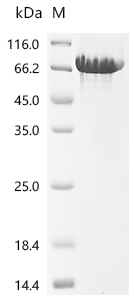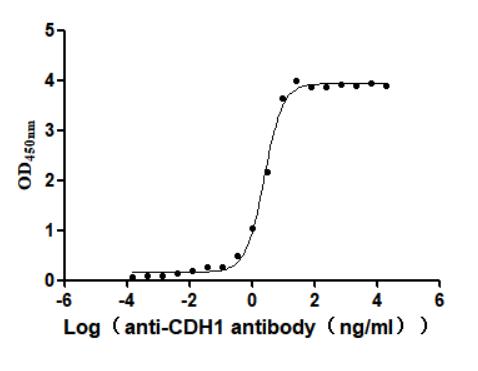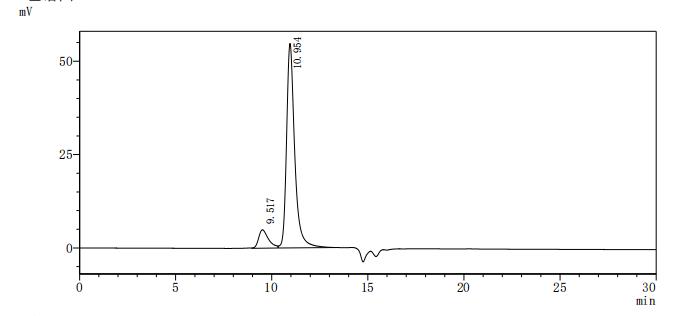The recombinant Macaca fascicularis CDH1 protein is an active form of the E-cadherin protein expressed in mammalian cells, specifically within the region spanning amino acids 155 to 708 of the Macaca fascicularis CDH1 protein. The protein is tagged with a C-terminal 10xHis tag, allowing for easy isolation using nickel affinity chromatography. The purity of the recombinant CDH1 protein exceeds 95%, as confirmed by both SDS-PAGE and SEC-HPLC techniques. This high purity is essential for ensuring the reliability of experimental results, particularly in functional assays. The activity of CDH1 has been assessed using a functional ELISA, where it was immobilized at a concentration of 2 μg/mL. The protein demonstrated a strong binding affinity to the anti-CDH1 recombinant antibody (CSB-RA005034MA2HU), with an EC50 value ranging from 2.256 to 2.744 ng/mL.
The CDH1K protein found in various primates including Macaca fascicularis, plays a vital role in cellular adhesion processes, particularly in maintaining the integrity of epithelial tissues and facilitating intercellular communication [1][2][3]. In Macaca fascicularis, the function of CDH1K may have remarkable implications for both basic biology and biomedical research, as cadherins are critical in developmental processes and tissue morphogenesis [4][5].
Research indicates that CDH1K contributes to the structural framework of epithelial cells by mediating the attachment between adjacent cells, which is crucial for maintaining tissue architecture and function. This protein is notable for establishing cellular polarity and regulating cell signaling pathways that influence cellular behavior, such as proliferation and differentiation [6][7]. In the context of Macaca fascicularis specifically, studies on related protein families like the cadherin superfamily reveal that homology and functional conservation across primate species ensure that insights derived from studies on this protein can be pivotal in understanding analogous human conditions [8][9][3].
Moreover, the specific expression patterns and functional roles of CDH1K and related proteins in Macaca fascicularis have been linked to various physiological processes, including response mechanisms to environmental stressors and involvement in immune responses [10][11]. The evolutionary conservation of CDH1K amongst primate species, as evidenced by shared genetic frameworks, underscores the potential of this protein as a model for studying both evolutionary biology and the pathological conditions related to cadherin dysfunctions, such as cancer metastasis and developmental disorders [12][13].
References:
[1] A. Bauernfeind, A. Sousa, et al. A volumetric comparison of the insular cortex and its subregions in primates. Journal of Human Evolution, vol. 64, no. 4, p. 263-279, 2013. https://doi.org/10.1016/j.jhevol.2012.12.003
[2] Z. Zhou, P. Du, et al. Homologous or heterogenous vaccination boosters enhance neutralizing activities against sars‐cov‐2 omicron ba.1 variant. Medcomm, vol. 3, no. 2, 2022. https://doi.org/10.1002/mco2.143
[3] E. Robertson, S. Boehnke, et al. Comparison of cerebrospinal fluid biomarkers relevant to neurodegenerative diseases in healthy cynomolgus and rhesus macaque monkeys. 2021. https://doi.org/10.1101/2021.03.01.433384
[4] E. Pignatti, L. Casarini, et al. Aromatase expression in human peripheral blood leucocytes (pbls) and in various tissues in primates: studies in elderly humans and cynomolgus monkeys. Journal of Medical Primatology, vol. 41, no. 6, p. 372-383, 2012. https://doi.org/10.1111/jmp.12000
[5] S. Mariya, F. Dewi, et al. Isolation and characterization of c-c chemokine ligand 7 (ccl7) in cynomolgus macaques. Hayati Journal of Biosciences, vol. 26, no. 3, p. 129, 2019. https://doi.org/10.4308/hjb.26.3.129
[6] S. Kimani, V. Moterroso, et al. Cross-species and tissue variations in cyanide detoxification rates in rodents and non-human primates on protein-restricted diet. Food and Chemical Toxicology, vol. 66, p. 203-209, 2014. https://doi.org/10.1016/j.fct.2014.01.047
[7] E. Paietta, S. Kraberger, et al. Diverse circular dna viral communities in blood, oral, and fecal samples of captive lemurs. Viruses, vol. 16, no. 7, p. 1099, 2024. https://doi.org/10.3390/v16071099
[8] J. Desantis, B. Mercorelli, et al. Indomethacin-based protacs as pan-coronavirus antiviral agents. European Journal of Medicinal Chemistry, vol. 226, p. 113814, 2021. https://doi.org/10.1016/j.ejmech.2021.113814
[9] M. Fong, S. Rashdi, R. Yusof, & Y. Lau. Genetic diversity, natural selection and haplotype grouping of plasmodium knowlesi gamma protein region ii (pkγrii): comparison with the duffy binding protein (pkdbpαrii). Plos One, vol. 11, no. 5, p. e0155627, 2016. https://doi.org/10.1371/journal.pone.0155627
[10] H. Yan, X. Peng, et al. Molecular determinants of hepatitis b and d virus entry restriction in mouse sodium taurocholate cotransporting polypeptide. Journal of Virology, vol. 87, no. 14, p. 7977-7991, 2013. https://doi.org/10.1128/jvi.03540-12
[11] C. Girard-Buttoz, M. Heistermann, E. Rahmi, M. Agil, P. Fauzan, & A. Engelhardt. Costs of and investment in mate-guarding in wild long-tailed macaques (macaca fascicularis): influences of female characteristics and male–female social bonds. International Journal of Primatology, vol. 35, no. 3-4, p. 701-724, 2014. https://doi.org/10.1007/s10764-014-9775-3
[12] S. Platto, J. Zhou, Y. Wang, H. Wang, & E. Carafoli. Biodiversity loss and covid-19 pandemic: the role of bats in the origin and the spreading of the disease. Biochemical and Biophysical Research Communications, vol. 538, p. 2-13, 2021. https://doi.org/10.1016/j.bbrc.2020.10.028
[13] C. Meyer, N. Scalzitti, A. Jeannin‐Girardon, P. Collet, O. Poch, & J. Thompson. Understanding the causes of errors in eukaryotic protein-coding gene prediction: a case study of primate proteomes. 2020. https://doi.org/10.21203/rs.3.rs-50810/v1









